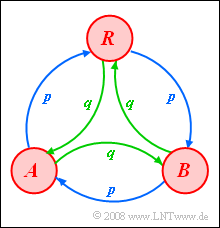Exercise 1.7Z: BARBARA Generator
From LNTwww
Here we consider a ternary random generator with symbols $A$, $B$ and $R$, which can be described by a homogeneous and stationary first order Markov chain.
- The transition probabilities can be taken from the sketched Markov diagram.
- For the first three subtasks, $p = 1/4$ should always hold.
Hints:
- The exercise belongs to the chapter Markov Chains.
Questions
Musterlösung
(1) Correct are the second and third suggested solutions:
- The sum of all outgoing arrows must always be $1$. Therefore $q = 1 - p$ holds.
- Because of the symmetry of the Markov diagram, the ergodic probabilities are all equal:
- $${\rm Pr}(A) ={\rm Pr}(B) ={\rm Pr}(R) = 1/3.$$
(2) If one is in the state $B$ at the starting time $\nu=0$, because of ${\rm Pr}(B\hspace{0.05cm}|\hspace{0.05cm}B) = 0$ the state $B$ is not possible at time $\nu=1$.
- One fails here already with the initial letter $B$:
- $$p_{\rm B} \; \underline{ =0}.$$
- For the calculation of $p_{\rm A}$ it should be noted: Starting from $A$ one goes in the Markov diagram first to $B$ $($with probability $q)$, then five times clockwise $($each time with probability $p)$ and finally from $R$ to $A$ $($with probability $q)$. Meaning:
- $$p_{\rm A} = q^2 \hspace{0.05cm}\cdot \hspace{0.05cm} p^5 = 3^2 / 4^7 \hspace{0.15cm}\underline {\approx 0.549 \hspace{0.05cm}\cdot \hspace{0.05cm} 10^{-3}}.$$
- In a similar way, one obtains:
- $$p_{\rm R} = q \hspace{0.05cm}\cdot \hspace{0.05cm} p^6 = 3 / 4^7 \hspace{0.15cm}\underline {\approx 0.183 \hspace{0.05cm}\cdot \hspace{0.05cm} 10^{-3}}.$$
(3) By averaging over the conditional probabilities we obtain:
- $${\rm Pr}(\rm BARBARA) = p_{\rm A} \hspace{0.05cm}\cdot \hspace{0.05cm} {\rm Pr}(A) \hspace{0.1cm} + \hspace{0.1cm}p_{\rm B} \hspace{0.05cm}\cdot \hspace{0.05cm} {\rm Pr}(B) \hspace{0.1cm} + \hspace{0.1cm}p_{\rm R} \hspace{0.05cm}\cdot \hspace{0.05cm} {\rm Pr}(R).$$
- This leads to the result:
- $${\rm Pr}(\rm BARBARA) = {1}/{3} \cdot \left( q^2 \hspace{0.05cm}\cdot \hspace{0.05cm} p^5 \hspace{0.1cm} +\hspace{0.1cm}0 \hspace{0.1cm} +\hspace{0.1cm}q \hspace{0.05cm}\cdot \hspace{0.05cm} p^6 \right) = \frac{q \hspace{0.05cm}\cdot \hspace{0.05cm} p^5 }{3} \cdot{p+q} = \hspace{-0.15cm} \frac{q \hspace{0.05cm}\cdot \hspace{0.05cm} p^5 }{3} \hspace{0.15cm}\underline { \approx 0.244 \hspace{0.05cm}\cdot \hspace{0.05cm} 10^{-3}}.$$
(4) The probability calculated in (3) is $p^5 \cdot (1-p)/3$, where $q= 1-p$ is considered.
- By setting the differential to zero, we obtain the governing equation:
- $$5 \cdot p^4 - 6 \cdot p^5 = 0 \hspace{0.5cm} \Rightarrow \hspace{0.5cm} p_{\rm opt} = 5/6 \hspace{0.15cm}\underline { \approx \rm 0.833}.$$
- This results in a value that is larger than the subtask (3) by a factor $90$ approximately:
- $${\rm Pr}\rm (BARBARA) \hspace{0.15cm}\underline { \approx 22 \hspace{0.05cm}\cdot \hspace{0.05cm} 10^{-3}}.$$
